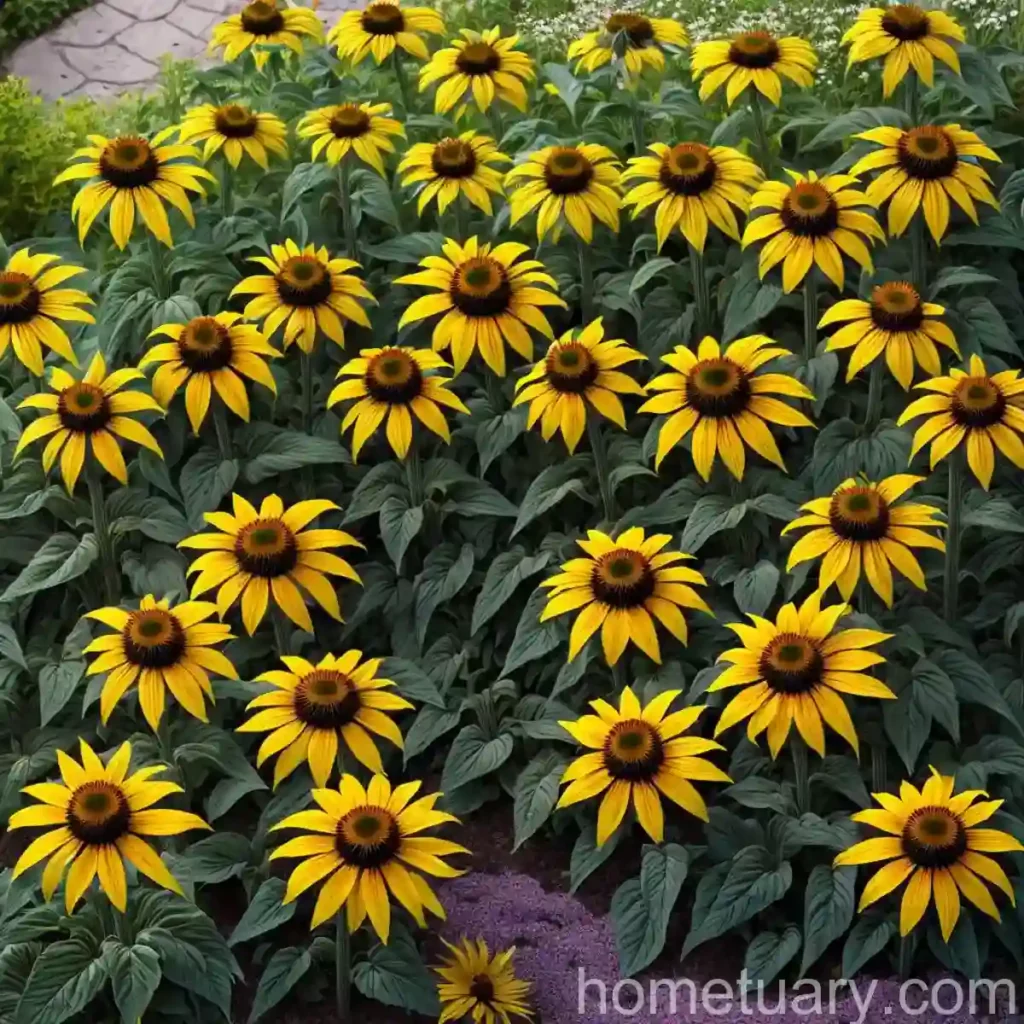Large Coneflower (Rudbeckia maxima ‘Golda Emanis’)
Gardening enthusiasts are always on the lookout for unique and beautiful plants to enhance their landscapes. Large coneflower, scientifically known as Rudbeckia maxima ‘Golda Emanis’, is a stunning perennial that captivates with its towering stems and striking golden petals. This article will delve into the aspects of cultivating and caring for the large coneflower, shedding light on its culture, uses, maintenance, common diseases, and much more. Whether you are a seasoned gardener or a novice plant enthusiast, this guide will equip you with the knowledge to grow and nurture this captivating plant successfully.
What is the Large Coneflower (Rudbeckia maxima ‘Golda Emanis’)?
The large coneflower, or Rudbeckia maxima ‘Golda Emanis’, is a striking perennial plant that belongs to the Asteraceae family. As the name suggests, this plant is distinguished by its impressive size, featuring tall sturdy stems that bear characteristic brown coneflowers with vibrant golden petals. This variety is a cultivar of the species Rudbeckia maxima and is renowned for its elegant appearance and resilience. Its eye-catching blooms make it a favorite among gardeners who seek to introduce a touch of grandeur and vibrancy to their outdoor spaces.
Key Takeaways – Large Coneflower (Rudbeckia maxima ‘Golda Emanis’)
Before delving into the nitty-gritty details of growing and caring for the large coneflower, let’s highlight some key takeaways about this captivating plant:
- Scientific Name: Rudbeckia maxima ‘Golda Emanis’
- Common Name: Large Coneflower
- Other Names: Golda Emanis Coneflower, Tall Coneflower Variety, Giant Coneflower Species
- Plant Type: Perennial
- Distinctive Feature: Golden Petals with Brown Cone Centers
- Sunlight: Full Sun to Partial Shade
- Watering Needs: Moderate
- Soil Type: Well-Draining
- Maintenance: Low
- Uses: Flower Beds, Landscaping, Cut Flowers
- Native: Southeastern United States
- Attracts: Butterflies, Bees, and Pollinators
With these key points in mind, let’s explore the culture, uses, and maintenance requirements of the large coneflower in more detail.
Culture of Large Coneflower (Rudbeckia maxima ‘Golda Emanis’)
Cultivating the large coneflower requires an understanding of its specific cultural needs to ensure optimal growth and blooming. By paying attention to factors such as water, sunlight, soil, and fertilization, you can provide an environment that allows this impressive perennial to thrive.
Water
Like many perennial plants, the large coneflower appreciates moderate and consistent moisture. While it is relatively drought-tolerant once established, regular watering is essential, especially during periods of prolonged drought. Adequate moisture contributes to healthy growth and robust flowering. However, it’s important to avoid waterlogged conditions, as excessively wet soil can lead to root rot and other issues.
Sunlight
One of the defining characteristics of the large coneflower is its preference for full sun. This plant thrives in locations where it receives at least 6-8 hours of direct sunlight per day. Ample sunlight is crucial for promoting vigorous growth and abundant flowering. While it can tolerate some shade, a sunny spot is ideal for ensuring the best performance and bloom production.
Fertilizer
In terms of fertilization, the large coneflower is relatively undemanding. A balanced, all-purpose fertilizer can be applied in early spring as new growth emerges. It’s important to follow the manufacturer’s recommendations regarding application rates and frequency. Over-fertilizing can lead to excessive foliage at the expense of flowering, so moderation is key when feeding this resilient plant.
Soil
The large coneflower thrives in well-draining soil with a rich organic content. While it is adaptable to various soil types, including clay and loam, it is crucial to ensure that the soil does not become waterlogged. Amending the soil with organic matter, such as compost, can improve its fertility and drainage, creating an optimal environment for the large coneflower to flourish.
Pruning
Pruning requirements for the large coneflower are minimal. Deadheading spent blooms can prolong the flowering period and prevent self-seeding, particularly in garden settings. Additionally, removing any damaged or withered foliage can promote a tidy appearance and prevent the spread of diseases. However, the natural form of the large coneflower is part of its charm, and excessive pruning is generally unnecessary.
Propagation
Propagation of the large coneflower can be achieved through division or by collecting and sowing seeds. Division is typically carried out in early spring, allowing the new divisions to establish before the onset of summer. Collecting ripe seeds from the cone centers and sowing them in a prepared seedbed can also yield new plants, with the offspring often exhibiting variations in flower color and size.
Container Popularity
The large coneflower’s impressive stature and striking blooms make it a popular choice for container gardening. When grown in large containers, it adds vertical interest and a touch of drama to patio settings, balconies, and porches. Selecting a well-draining potting mix and ensuring adequate watering and sunlight are essential for successfully growing the large coneflower in containers.
Uses of Large Coneflower (Rudbeckia maxima ‘Golda Emanis’)
The large coneflower offers a myriad of uses in garden and landscape settings, as well as in floral arrangements. Its adaptability, resilience, and aesthetic appeal make it a versatile addition to outdoor spaces and a valuable resource for cut flower enthusiasts.
Garden Design
In garden design, the large coneflower serves as a focal point, especially in perennial borders and mixed plantings. Its tall, architectural form adds vertical interest and complements a wide range of companion plants. It also makes a striking statement when mass-planted, creating a sea of golden blooms that attract attention and pollinators alike.
Cut Flowers
Rudbeckia maxima ‘Golda Emanis’ is a favorite among flower enthusiasts for creating stunning cut flower arrangements. Its robust stems and long-lasting blooms make it a valuable addition to floral displays, bringing the beauty of the garden indoors. Whether used as a standalone bouquet or combined with other garden favorites, its striking presence is sure to captivate.
Landscaping
In landscaping, the large coneflower contributes to wildlife-friendly gardens, drawing in butterflies, bees, and other pollinators with its abundant nectar and pollen. Its adaptability to various soil types and its preference for sunny locations make it an ideal candidate for naturalistic landscapes, prairie-style plantings, and native gardens.
Border Planting
As a border plant, the large coneflower creates a stunning transition between different areas of the garden. Its commanding height and prolific blooms form a natural barrier while introducing vibrant color and texture. Planted alongside ornamental grasses, salvias, and other perennials, it adds dynamic visual interest to border plantings.
Common Diseases and Pests Affecting Large Coneflower (Rudbeckia maxima ‘Golda Emanis’)
While the large coneflower is relatively resilient, it can be susceptible to certain diseases and pests that may hinder its growth and flowering. Understanding these potential challenges is essential for implementing preventive measures and addressing any issues promptly.
Common Diseases
-
Powdery Mildew: This fungal disease manifests as a powdery white coating on the foliage, often affecting plants in humid conditions. Proper spacing, good air circulation, and avoiding overhead watering can help prevent powdery mildew.
-
Leaf Spot: Leaf spot diseases may occur under conditions of high humidity and prolonged leaf wetness. They appear as dark, water-soaked lesions on the foliage. Removing and disposing of infected leaves and practicing proper sanitation can help manage leaf spot diseases.
Disease Diagnosis
Early detection and accurate diagnosis of diseases are crucial for implementing effective management strategies. Carefully inspecting the foliage for any signs of discoloration, lesions, or unusual growth can provide valuable clues about the presence of diseases. Consulting with local extension services or plant clinics can aid in the accurate diagnosis of specific diseases affecting the large coneflower.
Common Pests
-
Aphids: These small, soft-bodied insects may infest the tender new growth of the large coneflower, causing distortion and stunted growth. Natural predators, such as ladybugs, lacewings, and parasitic wasps, can help keep aphid populations in check.
-
Japanese Beetles: These voracious feeders may skeletonize the foliage of the large coneflower, causing aesthetic damage. Monitoring for their presence and employing physical removal or insecticidal control measures can help mitigate their impact.
Botanist’s Tips for Caring for Large Coneflower (Rudbeckia maxima ‘Golda Emanis’)
To ensure the successful cultivation of the large coneflower and maximize its ornamental value, it is beneficial to keep certain botanist’s tips in mind. These pointers can enhance your approach to growing and caring for this stunning perennial plant.
-
Mulching: Applying a layer of organic mulch around the base of the large coneflower can help conserve soil moisture, moderate soil temperature, and suppress weed growth. Additionally, a mulch layer contributes organic matter to the soil as it decomposes, enriching the growing environment.
-
Staking: Given its tall stature, staking may be necessary to provide support for the large coneflower’s stems, particularly in regions prone to strong winds or heavy rainfall. Using discreet stakes and ties can prevent stem breakage and maintain the plant’s upright form.
-
Wildlife Gardening: Embracing the large coneflower as part of a wildlife-friendly garden promotes biodiversity and ecological balance. Its nectar-rich flowers attract beneficial insects and pollinators, contributing to a thriving ecosystem within the garden.
-
Drought Tolerance: While the large coneflower benefits from regular watering, it exhibits a degree of tolerance to dry conditions once established. This quality makes it suitable for xeriscapes and water-wise landscapes, where it can thrive without excessive irrigation.
Fun Facts about Large Coneflower (Rudbeckia maxima ‘Golda Emanis’)
Uncovering interesting tidbits about the large coneflower adds an enjoyable dimension to the gardening experience. From historical significance to ecological contributions, here are some fun facts about this captivating plant:
-
Ecosystem Role: The large coneflower plays a vital role in supporting local ecosystems by providing nectar and pollen for a diverse array of pollinators, including butterflies, bees, and beneficial insects.
-
Historical Inspiration: The distinctive appearance of the large coneflower has served as inspiration for art, literature, and cultural expressions over centuries, symbolizing resilience and natural beauty.
-
Adaptive Resilience: Rudbeckia maxima ‘Golda Emanis’ is native to the Southeastern United States, where it has evolved to thrive in a variety of environmental conditions, showcasing its adaptive resilience as a native species.
With these fun facts in mind, you can appreciate the large coneflower’s significance beyond its ornamental appeal, adding depth to your admiration for this remarkable plant.
Links to External Resources
For further exploration of large coneflower (Rudbeckia maxima ‘Golda Emanis’) and related topics, the following external resources provide valuable information, insights, and visual inspiration:
- The Royal Horticultural Society (RHS): RHS – Rudbeckia maxima ‘Golda Emanis’
- Missouri Botanical Garden: Rudbeckia maxima ‘Golda Emanis’ – Missouri Botanical Garden
- University of Florida IFAS Extension: Rudbeckia maxima Care and Culture
These resources offer a wealth of knowledge on the large coneflower and its cultivation, providing practical guidance, expert recommendations, and stunning visuals to enrich your understanding and appreciation of this extraordinary plant.
In conclusion, the large coneflower, also known as Rudbeckia maxima ‘Golda Emanis’, stands as a testament to nature’s artistry and resilience. With its towering stems, golden petals, and ecological contributions, it embodies timeless beauty and environmental harmony. By integrating this remarkable plant into our gardens and landscapes, we not only infuse our surroundings with vibrant color and vitality but also support the intricate web of life that thrives alongside us. As you embark on the journey of cultivating and caring for the large coneflower, may the insights shared in this article serve as a source of inspiration and guidance, enhancing your appreciation for this iconic perennial and the wonders of the natural world.
As a plant scientist, I have woven together a comprehensive guide to large coneflower (Rudbeckia maxima ‘Golda Emanis’), encompassing its cultural requirements, uses, maintenance, fun facts, and more. I hope this article provides valuable insights and practical knowledge for plant enthusiasts and gardeners seeking to incorporate this magnificent plant into their outdoor spaces. Remember to embrace the beauty and resilience of the large coneflower, and may it enrich your gardening endeavors with its enduring charm and ecological significance.















